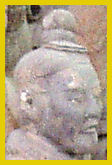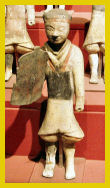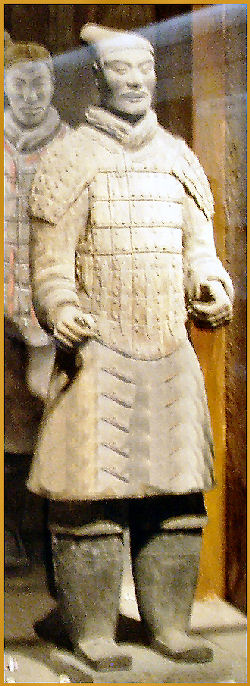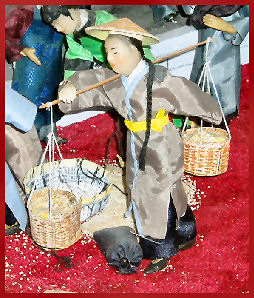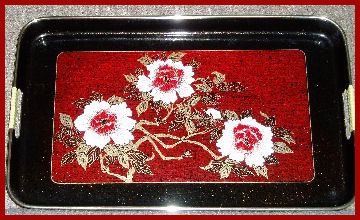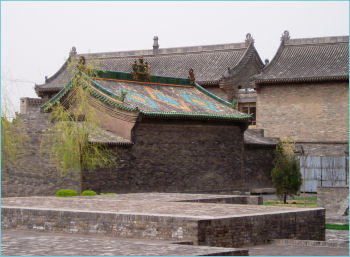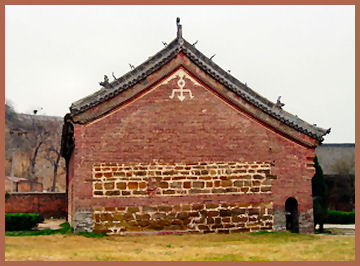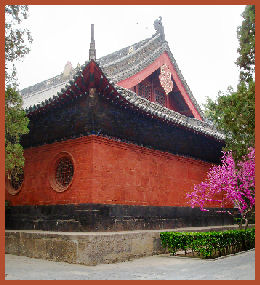HAN CULTURE
Introduction
The culture of the Han dynasties was built on the foundations established by the Qin dynasty but they had two striking differences.
Firstly, THE WAY THE HAN PERCEIVED THEMSELVES was very different to the way the Qin saw themselves. This is represented in the two very different styles of clay warriors produced and is why these two images have been used for the main banner of this website.
On the one hand the Qin warriors are stocky, well armed and show amazing details and differences. They are also full human size. On the other hand the Han warriors are lightly armed, lightly dressed, slim and all look fairly similar. They are in miniature, often one third size and smaller. The comparison can be seen below. As well, figurines of the ordinary people of the periods show the same differences, The Qin kneeling figurine is half a metre tall. The standing Han figurines are less than 30 centimetres tall.
|
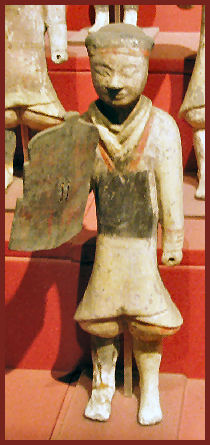 |
|---|---|
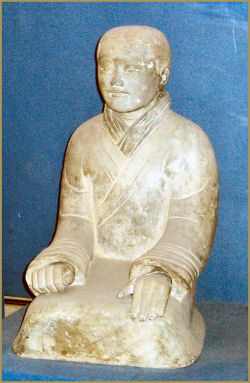 |
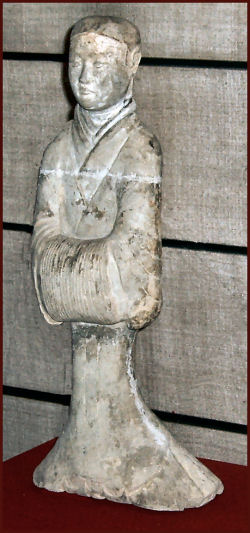 |
Secondly, the dynasties differed IN THE USE OF COLOUR in everything they did . The Qin people wore monochromatic clothes, usually of quiet colours. The Han did the opposite. As knowledge and experience of more and more chemicals widened as a result of seeking the elixer of life, so the use of brighter colours came about. This is the second reason for the choice of colours on this website. Throughout the whole period of both Qin and Han the pale yellow background on this website was the imperial colour with the blues and purples as highlights. It was not until the Ming period of the 1300 to 1600 AD period that the colour changed to the Imperial Gold we think of today. However, the ordinary Han people now wore much brighter clothing and this can be seen in the pictures below. These images have been taken from two dioramas - one at the Qiao Family Compound near Taiyuan and from Pingyao.
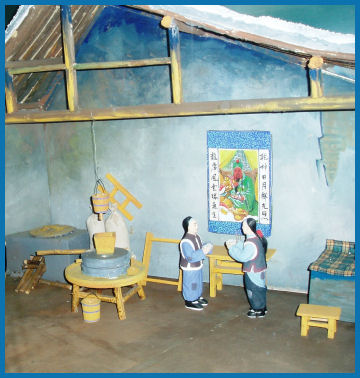 |
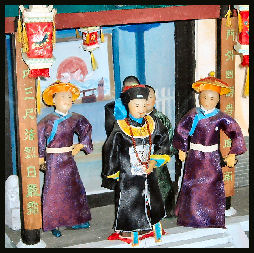 |
|---|---|
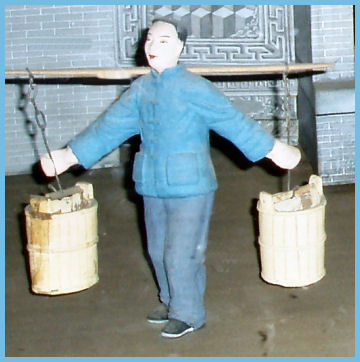 |
|
Education and the Confucian Examination
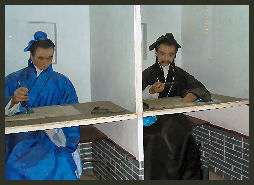
Under the Han dynasty there was a return to the importance of Confucianism. Any man wanting to enter the civil service had to complete a difficult exam which could go on for days. He was not allowed to leave the cell in which he sat until the exam was completed. It examined Confucian thoughts and ideas. At any point the civil servant wanted to be promoted, he had to sit another exam.
After the death of Wang Mang and the re-establishment of the Han Dynasty under Liu Xiu, a university was established at Luoyang which now became the capital of the dynasty. By the time of Liu Xiu's death in 57 AD the university had grown to more than 250 buildings with over 30 000 students (all male of course).
Philosophy
Yin and Yang 
Introduced into Confucian philosophy by Dong Zhongshu to try to explain why things change in the physical and social worlds. An explanation as to how the symbol was developed can be accessed through this link.
 Did you know?
Did you know?
Yin and Yang are two opposing forces in the world
| Yin is female and associated with | Yang is male and associated with |
|---|---|
|
the sun |
There are also Five basic elements. According to Confucianists these are fire, earth, metal, water and wood. Together with Yin and Yang this makes up our world.
Literature
As Confucianism became the formal basis of the dynasty's government and philosophy, so, too, did it become the basis for all literature. This is not surprising given that the education system was based on Confucianism and therefore Scholar Historians, Scholar Civil Servants, Scholar Poets and Scholar Officials all had the same training.
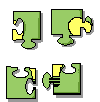 Facts and Figures
Facts and Figures
Despite Qin Shihuangdi's best attempts to destroy all but the most useful ancient texts, many survived or were re-written from memory. Early in the Han period (136 BC) five of these ancient texts were established as the most important Confucian texts. They were
- the Book of Songs (Shijing) - a collection of 300 poems dating from 1000 BC to 6th century BC - supposedly collected by Confucius himself
- the Book of Documents (Shujing or Shangshu) - detailed the powers of the kings of Zhou and how they and the rest of society, were supposed to behave
- The Book of Changes (Yijing) - interpretations of the divinations on yarrow stalks
- the book outlining what was acceptable behaviour (li)
- the Spring and Autumn Annals (Chunqiu) - a history of the state of Lu between 722 and 481 BC written by Confucius himself
After much discussion and debate, by late in the Han period, the understanding of these texts had been established and the emperor in AD 175 ordered the texts to be carved onto stone. Although it was not to be finished for some time, nevertheless, the results exist today and are kept at the Forest of Steles Museum in Xian. Below is part of the exhibition there. Even today paper prints of these carvings can be produced using the old methods.
Han scholars were not, however, limited to these books and produced prose and poetry to rival anywhere in the ancient world whether about history, beauty, power, the landscape or for amusement.
Fine Arts
Because of the increase in wealth of China and the advent of more leisure time for the nobility and elements of the gentry, the fine arts flourished. Sadly, little remains of the period but the following modern day replicas of the period can give us some idea of what existed. The first is a modern cloissonne dish and the second is a small lacquered papier mache box.
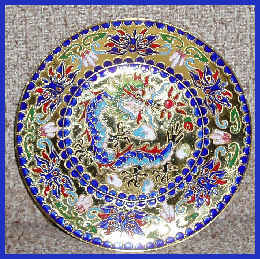 |
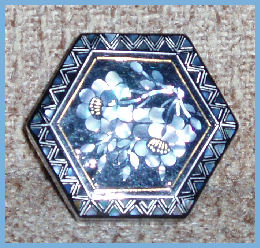 |
|---|
Next is a lacquered tray and a lacquered vase. Both are modern but demonstrate some of the skills of the past artisans. On the tray the design is very obvious. On the vase, the design is more subtle and requires special lighting to bring out its best.
Next to the vase is, at the top, a carved wooden container with lid. The style of this box is the basket shape used in almost all seating in the Chengdu area, in particular around the Dujiang Irrigation Project, Sechuan Province. Lastly is a modern sandalwood fan which is based on a traditional design. Fans came into more common use during the Han dynasty and remain a useful tool to today.
|
|
|---|---|
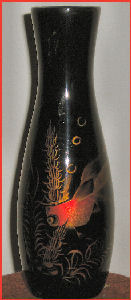 |
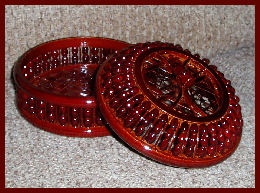 |
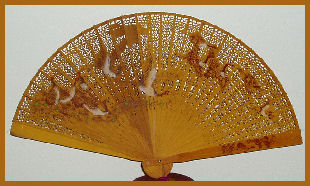 |
|
Architecture
By the Han dynasty the traditional roofing style of Chinese buildings was developing some differences. As early as the Eastern Zhou period (before the Qin period) roofs were described as "bird's wings spread out ready for flight" (the Book of Songs, quoted in China: 7000 Years of Discovery.
However, the style varied with the demands of the climate. In the north, with its cold winters, two sided roofs provided protection against the snow yet had only a short eave to allow the winter sun to enter the building but provide shade in summer. The building below, from Pingyao, typifies this style.
This northern China building and roof line is from the Court House complex at Pingyao. Pingyao frequently experiences heavy periods of snow and very cold winters therefore the roof line is simple, two sided and steep.
|
|
|---|---|
This temple, part of the Gongxian Grottoes complex, is at Gong Yi near Zhengzhou, also in the north. It was built during the Northern Wei period which followed the Han dynasty. It is one of the earliest temples still standing and has a very peculiar style. On the right (which is the front of the temple) it has a longer sloping roof than the back. This is because the front (where the doorway can be seen on the lower right of this facade) is a wide balcony in front of the actual temple. However, over the two millennia since this was built, the soil has filled the grounds and instead of the temple being the standard 10 to 12 steps OFF the ground, it is now almost at ground level. You should also note the Indian influence in the brickwork on the face of this building with the Hindu/Buddhist sign. |
|
| This is an old building at Baima Si, the White Horse Temple, near Luoyang. This temple site was the first Buddhist temple built in China and was founded in the 1st century AD. Although built in the Ming Dynasty, during the 1300 AD period, this building is said to be a copy of the earliest building on this site. Luoyang is further south than Pingyao and so this building has a more pronounced sweep to its roof. |
|
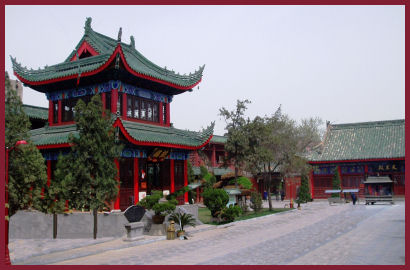 |
This a pavilion in the Xiang Guo Monastery in Kaifeng. Although a later copy it shows the increasing sweep to the roof line as their location moves further south. |
